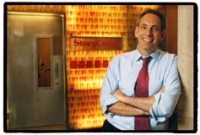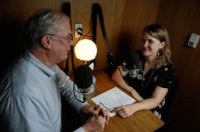
“Practice. Study your recorder and your microphone and learn how they “listen” and record. Then, understand how to optimize the quality of your recording so you can adapt to any recording situation.” Doug Boyd PhD, Director, Louie B. Nunn Center for Oral History, University of Kentucky Libraries
- Test out the recording device and all of its features before using it.
- Place the recorder closer to the interviewee than to the interviewer.
- Check the batteries (if there’s no power chord), and bring extra batteries!
- Bring an extra memory card
- Don’t talk over the interviewee – let them complete their thought, and then follow-up.
- Pay attention to the place of the recording
- Is there ambient noise to be concerned with?
- Is the location in a quiet room, but under an air conditioner?
- Is the location a noisy coffee shop (chatter, dishes, etc.)?
- Will external conversations be picked up by the recording device?
- Be prepared with questions to keep your interview as cohesive as possible
- Don’t forget to bring and use a backup recorder (if possible).
“The most important thing to keep in mind when interviewing is that capturing the interviewee’s testimony is the primary goal. A recorder should therefore be placed 2 feet from the interviewee, pointed at their mouth.” –Robert Budd, Memories to Memoirs (He got his Master’s Degree in the field!)
“I have told people before in oral history workshops to go ahead and spend the extra money and get two separate microphones – one for the interviewer and one for the interviewee – and make sure they are both the best quality that you can afford.” –Anonymous (do to the aforementioned confidentiality concerns, this client/expert prefers to remain anonymous, but did want their thoughts to be included.)
“Even on days where you’re most excited to get the interview started, be sure to spend the additional time it takes to test all of your audio equipment – in that specific setting, with that particular individual – before you dive into your conversations.” —Samuel J. Redman, Academic Specialist and Lead Interviewer for the Rosie the Riveter World War II Home Front Oral History Project, Regional Oral History Office, UC Berkeley
“Do as much research as time and money allow to avoid superficial questions and answers and probable frustration of the interviewee.” –Sally Smith Hughes, Academic Specialist, Science and Technology, Regional Oral History Office, UC Berkeley“Know your recording equipment so well that you can be 99 percent focused on the interview and 1 percent focused on the equipment.”–David Dunham Project Manager, WWII Home Front Oral History Project – Regional Oral History Office, UC Berkeley Web/Video Director







